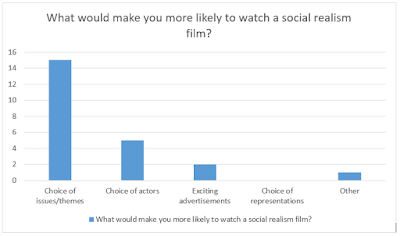I thought about the pros and cons of paper based and online surveys and decided to create both, with the same questions on each, so that it was accessible to as many people as possible. I created the paper based surveys on Word, with the following questions:
I also created a SurveyMonkey, which meant that I could reach people that I would have been able to hand a paper survey to, such as the one participant from Scotland. I used social media to my advantage for this in order to get as many people as possible to fill it out. Both surveys were the same, apart from on the paper based survey, I allowed the participants to tick as many options as they wanted for question 10. Overall, 23 people took part in my surveys. On several online surveys, people skipped questions and so my results are not completely full.
I have created a graph or chart for each question to display the spread of data across the different options that were available to the participants.
I have created a graph or chart for each question to display the spread of data across the different options that were available to the participants.
More females took the survey than males, with only 22% of males participating. No one chose the 'other' option. This may suggest that my audience may consist of a larger amount of females.
The majority of participants fell within the 16 to 24 age bracket. 26% were under 16, whilst 65% were 16 to 24, and 9% were 35 to 44. The most popular age group is likely to be from 15 to 24. This may imply that my audience is most likely to be 16 to 24.
The majority of participants were white/Caucasian. The participants that chose 'other' specified that they were 'English' and 'British Asian'. These results suggest that my audience is predominantly white/Caucasian.
Most of the participants had completed their GCSE's. I can infer from these results that most of my audience are currently completing A levels, or at Sixth Form age. No one who had taken my survey had a university degree.
The large majority of the participants were students, with the minority working in teaching and education, retail and leisure, and media and journalism. This suggests my audience is predominantly students.
Most of the survey participants live in South East England. The participant who chose 'other' specified that they lived in Scotland.
Most people stated that they watch 3 to 5 films on average each month. However, there was a wide spread of data for this question, as all options were chosen by the participants collectively. This suggests that my most of my audience watches at least 3 films a month, which is fairly frequent, considering that most of them are also students.
The majority of the participants enjoy social realism films, which means that I am looking in the right place to find an audience for my social realism film intro. A few said no, and many others didn't know what social realism was. One person skipped the question.
Most of the participants said that the choice of issues and themes is what would make them most likely to watch a social realism film. Others said that the choice of actors and the advertisements would influence them to watch, whilst two participants selected 'other'. One of these participants did not specify another option, whilst the other wanted to know what social realism was first in order to answer the question.
For this question, I allowed the participants to choose as many issues and/or themes as they wished. The three most popular were; homophobia and/or sexuality, sexism and/or gender, and mental health. The two least popular (excluding 'other') were; low economic status, and then terrorism, teenage pregnancy, immigration and racism and/or ethnicity, all with the same amount of votes.
Overall, the average participant for this survey was a white female aged 16 to 24 who has just completed her GCSEs and is still a student. This participant would would live in South East England and watch around 3-5 films a month. She enjoys social realism films and would watch them if they had themes and issues that appealed to her, which would include homophobia and/or sexuality and sexism.













No comments:
Post a Comment